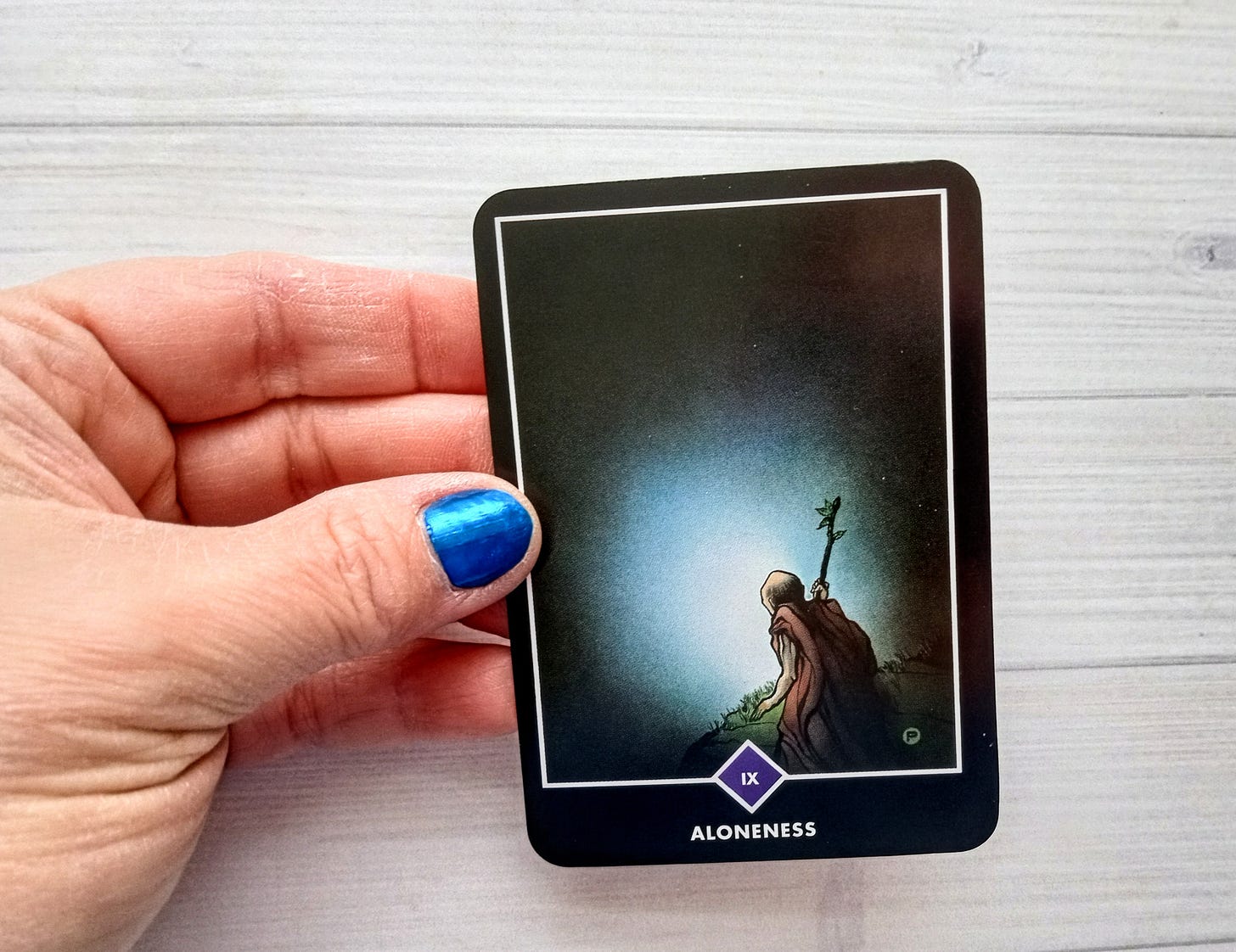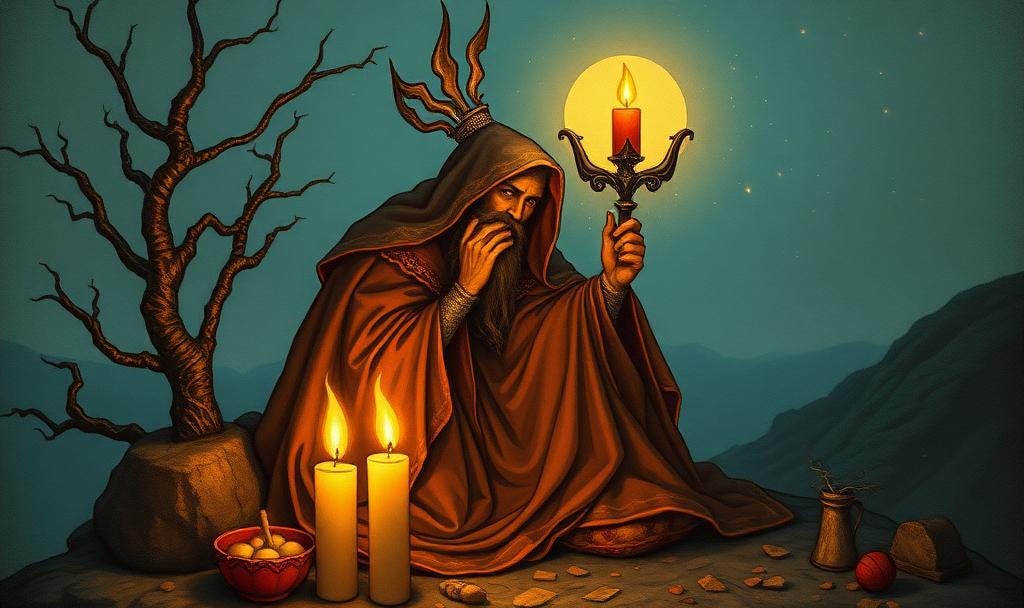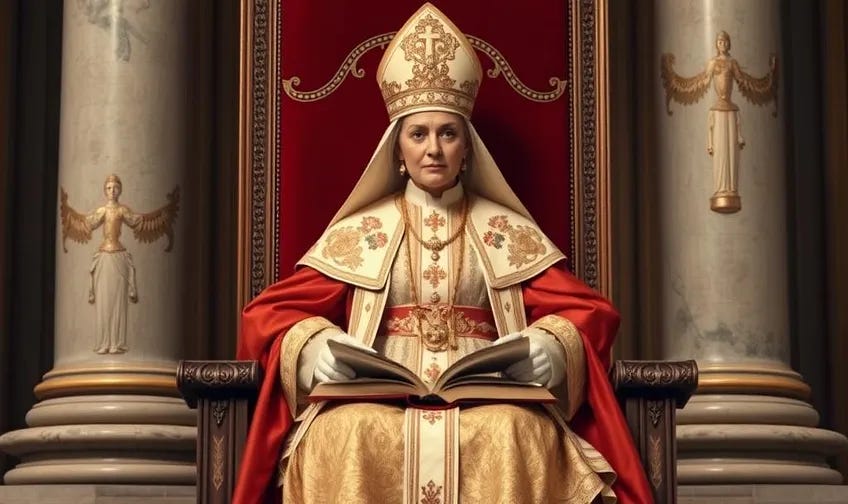Romanticizing The Hermit
You've Got to Be Kidding Me
“…although every human being is born as an original, increasingly more people die as pure copies.” — Hajo Banzhaf (from The Hermit chapter in Tarot and the Journey of the Hero)
To “romanticize” means to think about or describe something as being more attractive, interesting or better than it actually is.
Now that 2025 is a “Hermit Year” in Tarot numerology (2+0+2+5=9, with the ninth Major Arcana card being The Hermit), we're seeing a lot of “embrace your inner Hermit” types of content on social media (including here). Often, this archetype is confused with hygge—as well as extreme self-care, comfy robes, sleeping in on weekends, well-appointed mountain lodges or catching up on your waist-deep TBR pile.
Let me ask you this: based on most Hermit Tarot imagery, why would this be the assumption? The romanticization?
Below are The Hermit cards from nine different decks* (oh wow, didn't intend that…):
Do any of these images give you the warm fuzzies? Feelings of snuggling under a thick blanket with nary an appointment for the day? Endless cups of tea and scones in a cozy abode?
Um…no. In fact, if you swap the staff for a sickle, he would look like the Grim Reaper.
Wait, what? Death?
Surprise! I’ll get back to that esoteric precedent in a bit.
Instead, most Hermit Tarot imagery portrays or evokes:
Outdoor scene
Elevated location (mountain or cliff)
Cold (snow)
Solitude, seclusion & quietude
Barrenness
Elderly (hard won-wisdom that comes with age)
Bearded with long hair (often connected to ascetic monasticism)
Unkempt appearance (detachment from social mores or “crazy”)
Darkness or nighttime
Black or gray hooded robe
Small point of light held by the figure (lantern or candle)
A sense of foreboding
So let's sit with that for a moment.
Those elements and symbols emanate a completely different vibe than the romanticized “hygge Hermit”.
There's no luxury or comfort here—none brought by the Hermit himself, nor provided by a protective village.
Contrast this with the High Priestess, who looks pretty damn extravagant in her robes, fancy headpiece, embroidered background and marble columns…
In the companion book to her Wheel of Change Tarot, Alexandra Genetti says:
“The wise old man is the light inside us that points to meaning and helps us to find our own deep truths…The Hermit withdraws from society, both so that he may learn these things and so that he may live them as an example to the world at large. The High Priestess lives completely within her community, learning from experience about human interaction and the natural world, and returns the experience to her people in service as the priestess”.
The High Priestess is elevated by her community as a keeper of mysteries and knowledge; she lives among the people for the people. In his book Mystical Origins of the Tarot, Paul Huson offers compelling evidence that she is Pope Joan—who made dozens of appearances in German miracle plays. One of these, Frau Jutten, “tells the story of an ambitious woman who assumes make clothing, attains high ecclesiastical office, and finally becomes Pope. She is, alas, unmasked…” He goes on to say “many cartomancers see her as an archetype of feminist issues”.
The High Priestess contrasts with The Hermit, who lives in seclusion (apart from people)—and seeks knowledge of the Self. He cares about Truth, both personal and mystical. You have to go out of your way to find him, because he dwells in rarified air or a cave or somewhere not found on a map or by GPS.
If your frequency doesn't match his, you’ll not even recognize him in passing, because his robe will become a cloak of invisibility.
He may very well dispense profound wisdom, but he’ll not be one to set up a divination tent in the market nor deal out fortunes on social media. You have to travel to him…he will not come to you.
In both fairytale and myth, a traveler searching for something (a magical formula, healing elixir, a needed spell, holy grail, etc.) often encounters an old man that lives in seclusion, way off the beaten path. This Hermit bestows wisdom to the seeker, sometimes in the form of a prayer or a mystical phrase—or the traveler’s true name. In his book Tarot and the Journey of the Hero, Hajo Banzhaf explains:
‘This knowledge of the true name means that the hero—and therefore everyone who takes the path of becoming conscious—recognizes at this point who he truly is. And this is detached from everything that his parents, educators, relatives, or friends have told him he was up to that point. On the path of becoming conscious, this perception of true identity is the fruit that can only be found in silence and retreat.”
You cannot hear the “still small voice” (ala I Kings in the Old Testament) among the noise, among the crowd, among the scrolling. Banzhaf goes on to say about the voice of The Hermit:
“…fewer people learn their true name and many remain ignorant of who they really are. Instead, they become even more desperate in their attempt to imitate and portray something they are not, something considered to be chic, en vogue, or ‘in’…Jung assesses that our innate talent of imitating others ‘is of the greatest utility for collective purposes [but] most pernicious for individuation’”.

You cannot individuate (self-knowledge and becoming conscious) unless you trek alone—in the dark (the unknown) and the cold (stripped of the warmth of familiarity)— and “take the road less traveled” (like the poem by Robert Frost). After all, the word “hermit” derives from the Greek word erēmos which means “solitary.” The flame of your “true name”—who you are apart from ego or labels or conditioning—will light your way.
And when you take an unusual or solitary path? Be prepared to be misunderstood at best (is his avoidance snobbery?) or demonized at worst. In some cases, the Hermit is called “crazy”—a madman.
There is a price to pay when embracing the path of The Hermit. In times past, that may have included poverty or forms of self-denial, especially in monastic life. But in modern times, that “price” could be “missing out” (forgoing chasing what others aspire to or what others do), pursuing a new spiritual path (often to the chagrin of family or religious folks), finding that you no longer “fit in” (because you refuse to go along with BS), walking away from accolades (“likes”—or being “liked”). When you no longer crave being “seen” (or adored), you may feel lonely at first—but that first step of “aloneness” (being alone with yourself, in the quiet) is where you will find your “true name”.
So…what’s this about a connection to death that I alluded to earlier?
Well, it turns out that early versions of card 9 in the Tarot was called Il Tempo, which translates as “Time”. Various imagery from the 1400s and early 1500s shows an old man either carrying an hour glass, standing on an hour glass or (gulp) shoving an entire hourglass in his mouth (yikes, Dürer!). The symbolism of time in art, philosophy and myth is extensive—and beyond the scope of this post (but do research Saturn/Kronos, Rerum Edax and Virgo rulership in connection with The Hermit card). Suffice to say that time “devours” things—and that results in death. Mortality is with us, always. We were born to die.
Even in what appears to be a “lighthearted” deck like the Inner Child Cards: A Fairy-Tale Tarot (my very first deck, by the way!), there is the specter of death in card 9—via Snow White.
In the companion book, author Isha Lerner notes that in the original tale (penned by the brothers Grimm), the 7 dwarves are actually diamond-mining gnomes—which connect to the earthly realm. Snow White’s jealous stepmother attempts to kill her not once, but thrice. The first time, the wicked stepmother disguises herself as a lace merchant; tied too tightly around the waist, the lace restricts Snow’s breathing (the Greek word for breath is pneuma, which also translates as spirit) and she faints. The gnomes revive her. The second time, the stepmother disguises herself as a comb merchant. Suckered again, Snow buys a poisoned comb which pricks her scalp (ego identity). Yet again, the gnomes save her.
But the third attempt—the famous poisoned apple—renders Snow White comatose…but the gnomes cannot save her this time. Lerner notes that “earthly wisdom has run its course” (the rescuing gnomes) and an initiation ensues. “She can’t stay in the cottage (darkness) forever, so the gnomes place her in a glass coffin where the light streaming through the forest can illuminate her body, heart, and soul. She needs to come into the light.” When the prince comes to save her, he carries Snow White to his horse—and the poisoned apple becomes dislodged from her throat. “This is a symbolic clearing of the throat chakra and re-empowerment of Snow White’s primal wisdom”, says Lerner.
In her books and audios about chakras, Caroline Myss associates the Throat Chakra with staying true to your personal truth and finding your voice (among other things).
But before you can stay “true” to your personal truth, you have to find it—and that’s what The Hermit is all about.
*Hermit images are from The DruidCraft Tarot, Curious Travels Tarot, Phantasmagoric Theater Tarot, OSHO Zen Tarot, The Hieronymus Bosch Tarot, Universal Waite Tarot, The Guardians of the Night Tarot, The Wildwood Tarot and The Wheel of Change Tarot.









I've delayed reading this until I finished the Hermit piece I was working on this last couple of weeks as I was getting overwhelmed in the process (very addled menopausal brain at the moment).
This is such an in-depth and unflinching exploration, it's added another few layers to my relationship with this card. Thank you 🙏🙏
✨